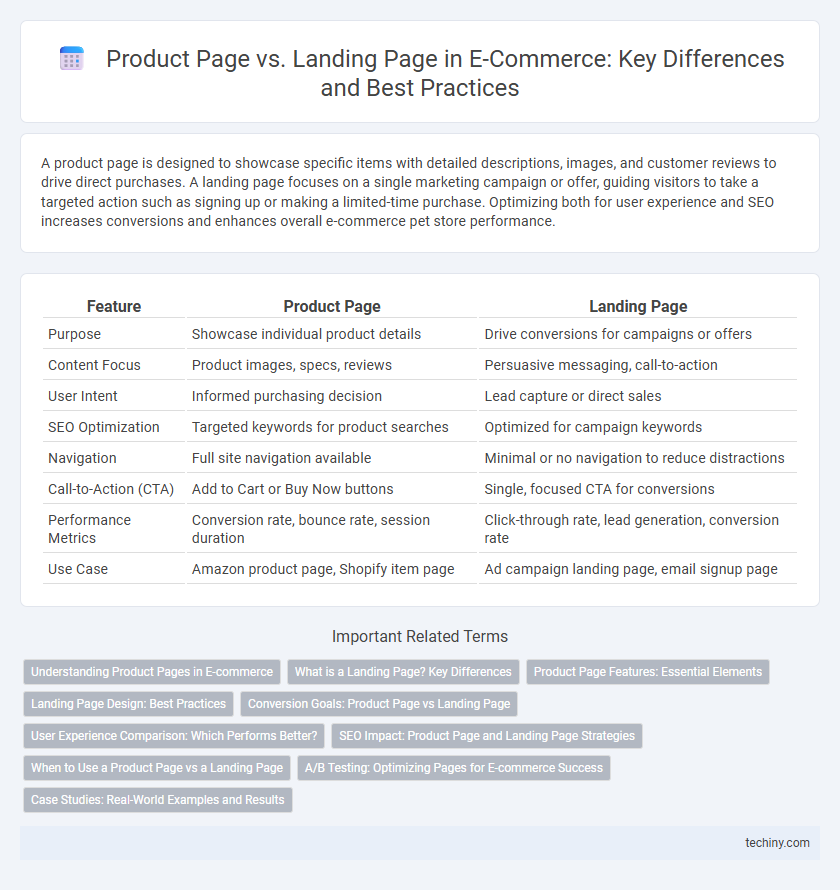A product page is designed to showcase specific items with detailed descriptions, images, and customer reviews to drive direct purchases. A landing page focuses on a single marketing campaign or offer, guiding visitors to take a targeted action such as signing up or making a limited-time purchase. Optimizing both for user experience and SEO increases conversions and enhances overall e-commerce pet store performance.
Table of Comparison
| Feature | Product Page | Landing Page |
|---|---|---|
| Purpose | Showcase individual product details | Drive conversions for campaigns or offers |
| Content Focus | Product images, specs, reviews | Persuasive messaging, call-to-action |
| User Intent | Informed purchasing decision | Lead capture or direct sales |
| SEO Optimization | Targeted keywords for product searches | Optimized for campaign keywords |
| Navigation | Full site navigation available | Minimal or no navigation to reduce distractions |
| Call-to-Action (CTA) | Add to Cart or Buy Now buttons | Single, focused CTA for conversions |
| Performance Metrics | Conversion rate, bounce rate, session duration | Click-through rate, lead generation, conversion rate |
| Use Case | Amazon product page, Shopify item page | Ad campaign landing page, email signup page |
Understanding Product Pages in E-commerce
Product pages in e-commerce showcase individual products with detailed descriptions, high-quality images, pricing, and customer reviews to drive conversions. These pages prioritize user experience by highlighting key product features, availability, and clear calls-to-action like "Add to Cart" or "Buy Now." Optimizing product pages with relevant keywords and structured data enhances search engine visibility and improves overall sales performance.
What is a Landing Page? Key Differences
A landing page in e-commerce is a standalone web page designed specifically to capture visitor information or drive a single, focused action such as a purchase or sign-up. Unlike product pages, which provide detailed descriptions, specifications, and reviews of individual products, landing pages emphasize clear, concise calls-to-action and minimal distractions to optimize conversion rates. Key differences include the purpose--landing pages target conversion objectives, whereas product pages focus on product education and discovery.
Product Page Features: Essential Elements
A product page in e-commerce must showcase high-quality images, detailed descriptions, and clear pricing to enhance user engagement and conversion rates. Essential elements include customer reviews, prominent call-to-action buttons, and product specifications to address shopper questions and build trust. Optimizing load speed and mobile responsiveness further improves user experience, reducing bounce rates and increasing sales.
Landing Page Design: Best Practices
Landing page design in e-commerce should prioritize clear product messaging, fast load times, and mobile responsiveness to maximize user engagement and conversions. Effective use of high-quality visuals, concise call-to-actions (CTAs), and persuasive social proof like reviews or ratings significantly enhance trust and reduce bounce rates. Incorporating A/B testing for layout, headlines, and CTA buttons helps identify the most impactful elements tailored to the target audience's behavior.
Conversion Goals: Product Page vs Landing Page
Product pages focus on detailed information, emphasizing product features, benefits, and customer reviews to drive purchase decisions, making them essential for conversion through direct sales. Landing pages target specific marketing campaigns with streamlined content and clear calls-to-action (CTAs) to capture leads or prompt quick actions, optimizing for higher conversion rates on targeted goals. The choice between product pages and landing pages depends on whether the goal is to educate and convert customers on a product or to generate leads and guide users toward a specific campaign objective.
User Experience Comparison: Which Performs Better?
Product pages enhance user experience by providing detailed product information, specifications, and customer reviews, which helps shoppers make informed purchasing decisions. Landing pages are designed for targeted campaigns with focused calls-to-action and streamlined navigation, increasing conversion rates for specific promotions. In e-commerce, product pages perform better for product discovery and engagement, while landing pages excel in driving targeted actions and sales efficiency.
SEO Impact: Product Page and Landing Page Strategies
Product pages and landing pages serve distinct SEO purposes in e-commerce, where product pages optimize for long-tail keywords related to specific items, improving organic visibility and conversion rates. Landing pages focus on targeted campaigns and high-volume keywords, enhancing paid traffic and lead generation through tailored content and clear calls to action. Effective SEO strategies combine keyword optimization, meta tags, load speed, and user experience elements to maximize search rankings and customer engagement on both page types.
When to Use a Product Page vs a Landing Page
Use a product page when showcasing detailed information, specifications, and customer reviews about a specific item to guide purchase decisions. Opt for a landing page to drive targeted traffic from campaigns, highlighting a single offer or promotion with a clear call-to-action. Product pages excel in supporting SEO and long-term sales, while landing pages are optimized for conversions and lead generation during marketing efforts.
A/B Testing: Optimizing Pages for E-commerce Success
A/B testing on product pages compares different layouts, images, and call-to-action buttons to maximize conversion rates and reduce bounce rates by tailoring elements to customer preferences. Landing page A/B tests focus on headline variations, promotional offers, and user experience factors to drive high-quality traffic and increase leads or sales. Data-driven insights from both pages refine marketing strategies, ensuring e-commerce platforms deliver optimized user engagement and profitability.
Case Studies: Real-World Examples and Results
Case studies reveal that optimized product pages enhance conversion rates by displaying detailed product information, high-quality images, and customer reviews tailored to specific buyer intent. In contrast, landing pages designed around targeted campaigns often generate higher traffic and engagement through focused messaging and clear calls-to-action, driving measurable increases in lead capture or sales. Analysis of real-world e-commerce brands like Amazon and Shopify-powered stores shows that integrating elements of both page types can maximize user experience and revenue growth.
Product Page vs Landing Page Infographic

 techiny.com
techiny.com